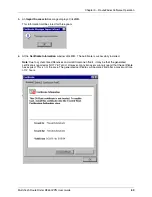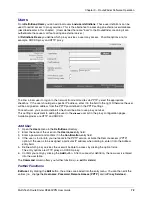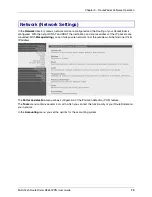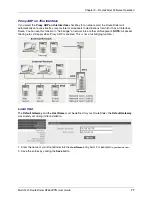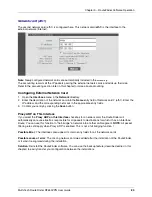
Chapter 3 – RouteFinder Software Operation
Multi-Tech RouteFinder RF650VPN User Guide
72
Users
From Definitions|Users you can add local users and user definitions. These user definitions can be
used to restrict access to proxy services. This is the alternative to accessing an external user database
(described earlier in this chapter). (Users defined here are "local" to the RouteFinder, meaning it can
authenticate these users without asking an external server.)
At Definitions|Users you define which proxy services a user may access. Possible options are, for
example, SOCKS proxy and HTTP proxy.
To allow a local user to log on to the network from remote sites via PPTP, select the appropriate
checkbox. If the user should get a specific IP address, enter it in the field to the right. Otherwise the user
will be assigned an address from the PPTP pool defined in the PPTP settings.
For each user, you can also define if s/he should be able to use proxy services.
This setting is equivalent to adding the user to the
allowed
user list in the proxy configuration pages.
Available proxies are HTTP and SOCKS.
Add User
1.
Open the Users menu in the Definitions directory.
2.
Enter the name of the user into the Username entry field.
3.
Enter a password and confirm it in the Confirmation entry field.
4.
If the user is to dial into your network via the PPTP service, activate the Remote access (PPTP)
option. If the user is to be assigned a particular IP address when dialing in, enter it into the Address
entry field.
5.
Define which proxy services the user will be able to access by clicking the option fields.
The entry options are HTTP proxy an SOCKS proxy.
6.
Confirm your entry by clicking the Add button. After a successful definition, the new user is entered
into the user table.
The Command column offers you further functions (i.e., edit or delete).
Further Functions
Edit user: By clicking the Edit button, the entries are loaded into the entry menu. You can then edit the
entries (i.e., change the Username, Password, Remote Access (PPTP), and/or Proxy Services).



